Memory chips maker Micron (NYSE:MU) reported results ahead of analysts' expectations in Q1 CY2024, with revenue up 57.7% year on year to $5.82 billion. On top of that, next quarter's revenue guidance ($6.6 billion at the midpoint) was surprisingly good and 9.9% above what analysts were expecting. It made a non-GAAP profit of $0.42 per share, improving from its loss of $1.91 per share in the same quarter last year.
Micron Technology (MU) Q1 CY2024 Highlights:
- Revenue: $5.82 billion vs analyst estimates of $5.35 billion (8.8% beat)
- EPS (non-GAAP): $0.42 vs analyst estimates of -$0.24 ($0.66 beat)
- Revenue Guidance for Q2 CY2024 is $6.6 billion at the midpoint, above analyst estimates of $6.00 billion
- Gross Margin (GAAP): 18.5%, up from -32.7% in the same quarter last year
- Inventory Days Outstanding: 162, up from 158 in the previous quarter
- Free Cash Flow was -$29 million compared to -$395 million in the previous quarter
- Market Capitalization: $103.8 billion
Founded in the basement of a Boise, Idaho dental office in 1978, Micron (NYSE:MU) is a leading provider of memory chips used in thousands of devices across mobile, data centers, industrial, consumer, and automotive markets.
Micron is one of the leading producers of both DRAM and NAND memory chips globally, though DRAM has consistently accounted for the majority of Micron’s revenues. Micron’s DRAM is mostly used in PCs, servers, networking gear, along with industrial and automotive verticals. NAND is used in the same end markets, along with a heavy weighting in consumer devices like smartphones and tablets.
Memory has the most volatile pricing dynamics in the semiconductors industry, which can result in Micron’s earnings results fluctuating wildly. As a result Micron’s valuation will often appear abnormally low compared to other semiconductors during the peak of the memory cycle, with the stock often trading for low to mid single digit forward earnings multiples (4x-8x) before dramatically expanding to high teens to mid twenties (18x-24x) when the cycle turns down.
Micron’s peers and competitors include Western Digital (NASDAQ:WDC), Seagate (NASDAQ:STX), SK Hynix (KOSI:000660), and Samsung (KOSI:005930).
Memory Semiconductors
The global memory chip market has become concentrated due to the highly commoditized nature of these semiconductors. Despite the market consolidation, DRAM and NAND are subject to wide pricing swings as supply and demand ebbs and flows. This plays itself out in the business models of memory producers, where the large, fixed cost bases required to produce memory chips in volume can become very profitable during times of rising prices due to high demand and tight supply but also can result in periods of low profitability when more supply is brought online or demand drops.
Sales Growth
Micron Technology's revenue growth over the last three years has been unimpressive, averaging 0.5% annually. As you can see below, this was a weaker quarter for the company, with revenue growing from $3.69 billion in the same quarter last year to $5.82 billion. Semiconductors are a cyclical industry, and long-term investors should be prepared for periods of high growth followed by periods of revenue contractions (which can sometimes offer opportune times to buy).
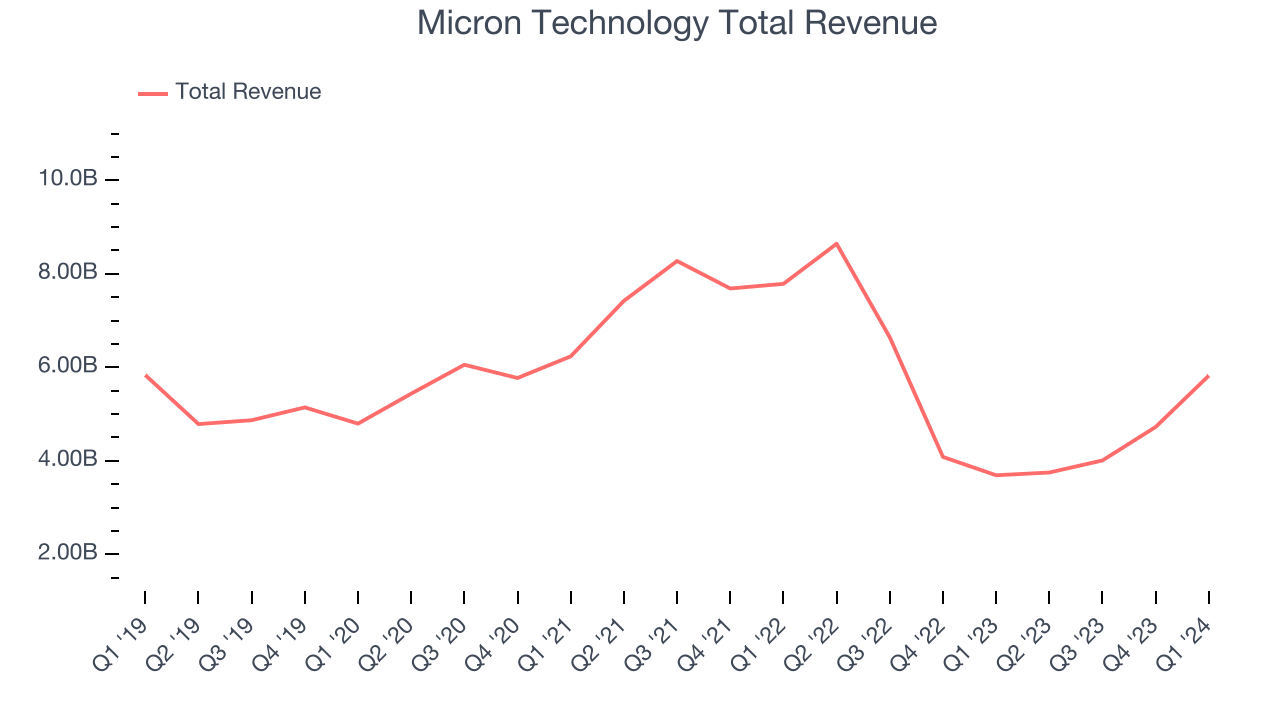
Micron Technology had a fantastic quarter as its 57.7% year-on-year revenue growth beat analysts' estimates by 8.8%. We believe the company is still in the early days of an upcycle, as this was just the second consecutive quarter of growth and a typical upcycle tends to last 8-10 quarters.
Micron Technology's management team believes its revenue growth will accelerate, guiding to 75.9% year-on-year growth next quarter. Wall Street expects the company to grow its revenue by 57.1% over the next 12 months.
Product Demand & Outstanding Inventory
Days Inventory Outstanding (DIO) is an important metric for chipmakers, as it reflects a business' capital intensity and the cyclical nature of semiconductor supply and demand. In a tight supply environment, inventories tend to be stable, allowing chipmakers to exert pricing power. Steadily increasing DIO can be a warning sign that demand is weak, and if inventories continue to rise, the company may have to downsize production.
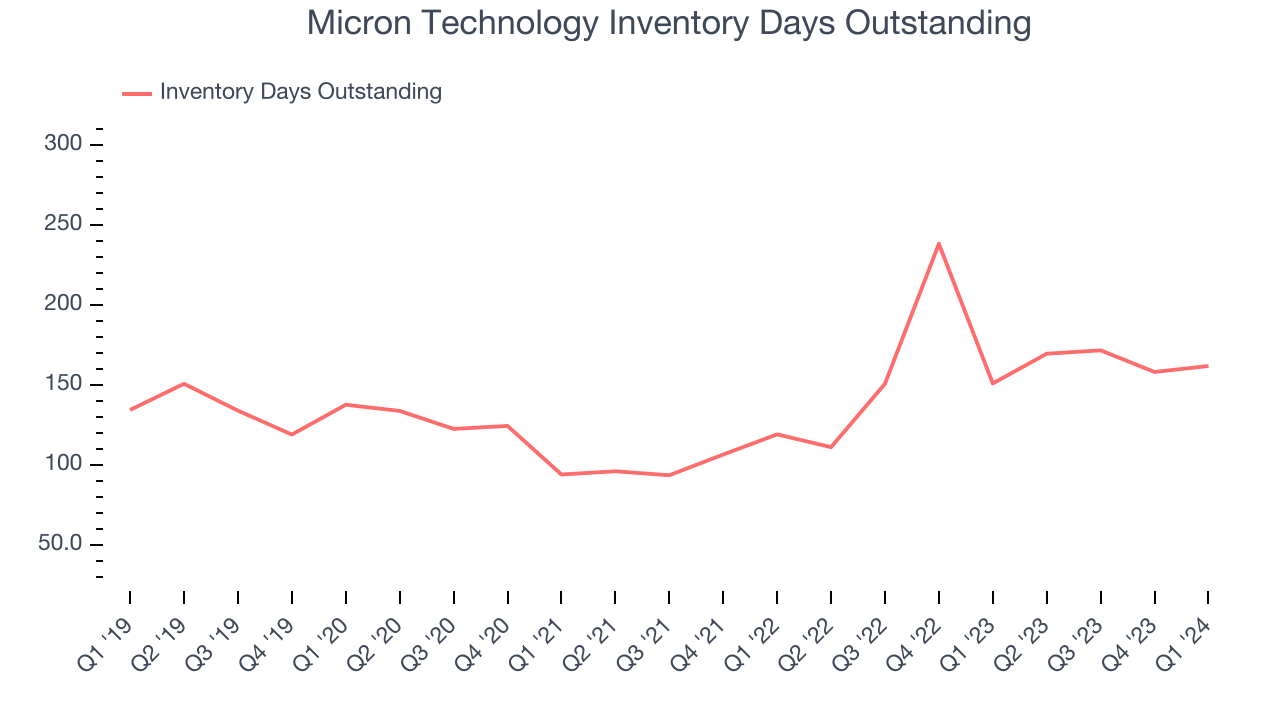
This quarter, Micron Technology's DIO came in at 162, which is 25 days above its five-year average, suggesting that the company's inventory has grown to higher levels than we've seen in the past.
Pricing Power
In the semiconductor industry, a company's gross profit margin is a critical metric to track because it sheds light on its pricing power, complexity of products, and ability to procure raw materials, equipment, and labor. Micron Technology's gross profit margin, which shows how much money the company gets to keep after paying key materials, input, and manufacturing costs, came in at 18.5% in Q1, up 51.2 percentage points year on year.
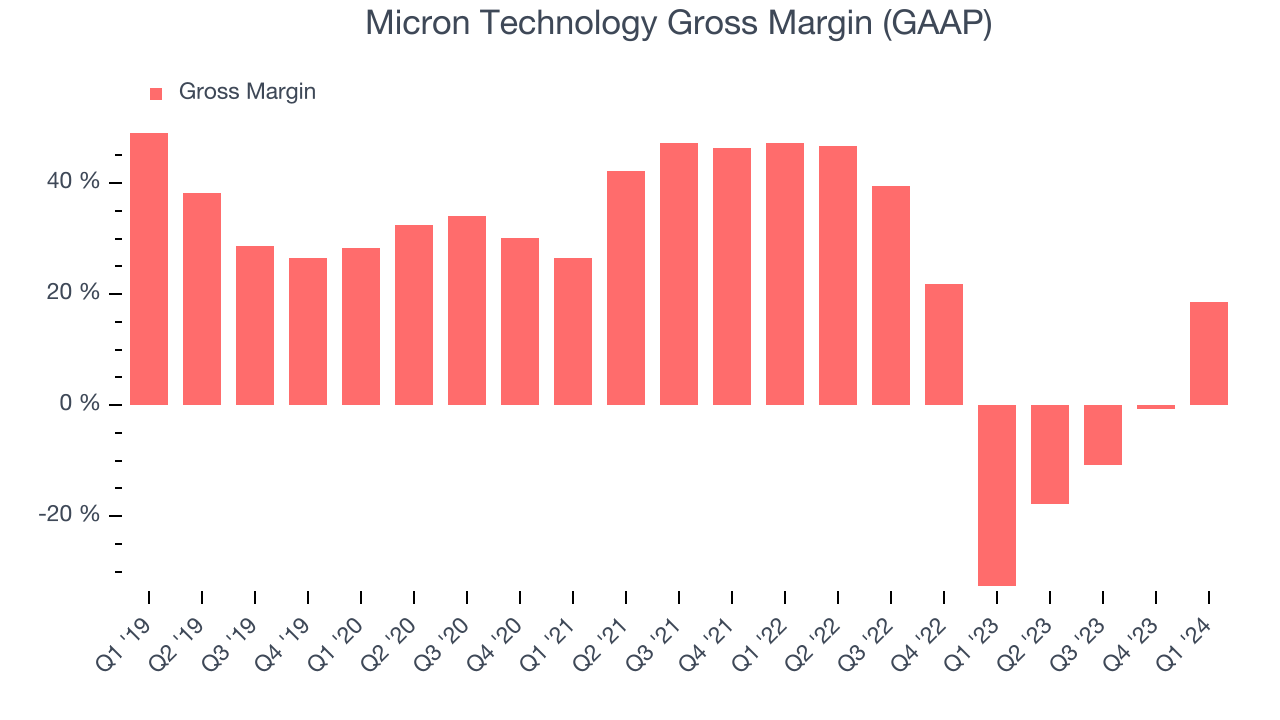
Micron Technology's gross margins have been trending down over the last 12 months, averaging -0.3%. This weakness isn't great as Micron Technology's margins are already far below other semiconductor companies and suggest shrinking pricing power and loose cost controls.
Profitability
Micron Technology reported an operating margin of 3.5% in Q1, up 59.7 percentage points year on year. Operating margins are one of the best measures of profitability because they tell us how much money a company takes home after manufacturing its products, marketing and selling them, and, importantly, keeping them relevant through research and development.
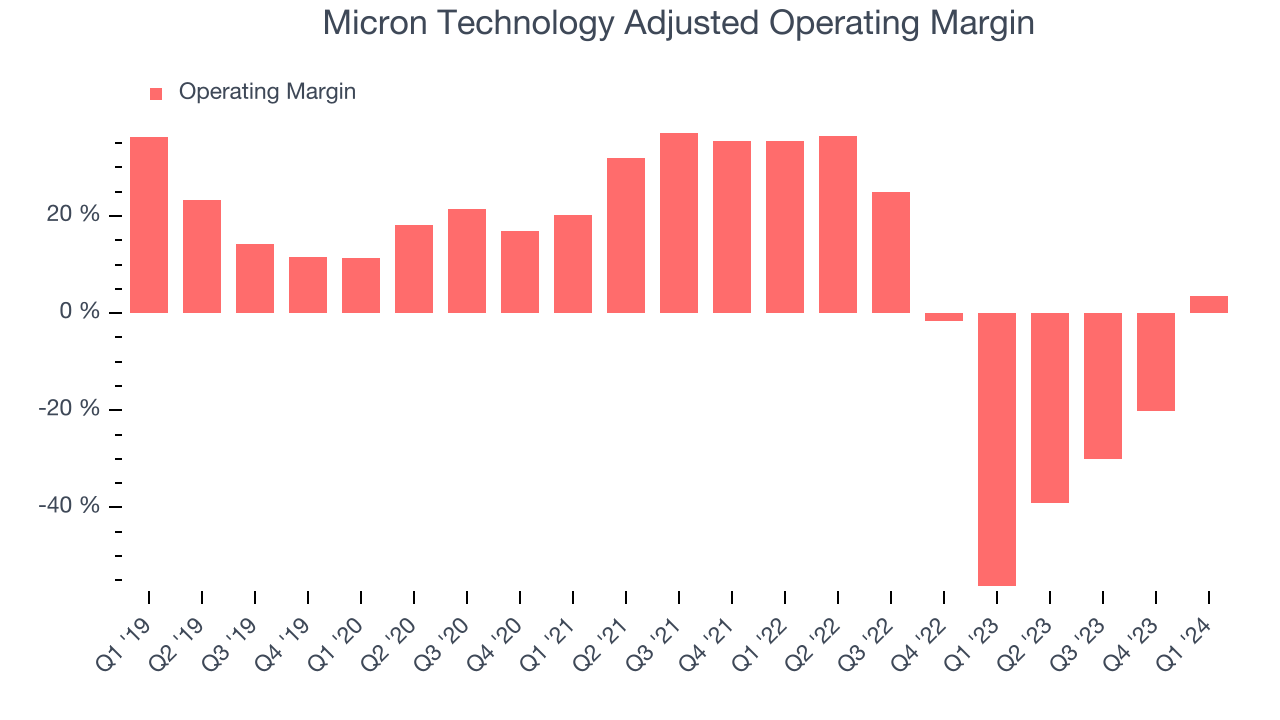
Micron Technology's operating margins have been trending down over the last year, averaging negative 18.7%. This is a bad sign for Micron Technology, whose margins are already among the lowest for semiconductors. The company will have to improve its relatively inefficient operating model.
Earnings, Cash & Competitive Moat
Analysts covering Micron Technology expect earnings per share to grow 208% over the next 12 months, although estimates will likely change after earnings.
Although earnings are important, we believe cash is king because you can't use accounting profits to pay the bills. Micron Technology's free cash flow came in at negative $29 million in Q1, up 98.4% year on year.
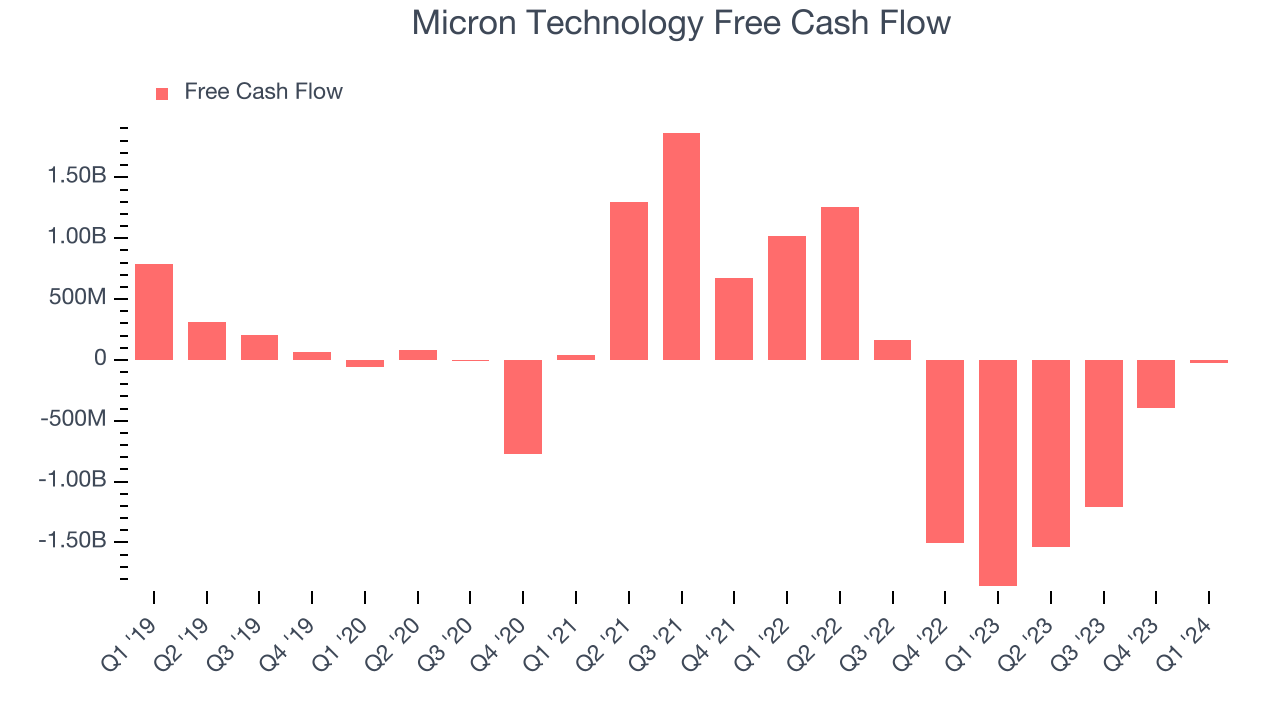
As you can see above, Micron Technology failed to produce positive free cash flow over the last 12 months and shareholders will likely want to see an improvement in the coming quarters.
Return on Invested Capital (ROIC)
EPS and free cash flow tell us whether a company was profitable while growing revenue. But was it capital-efficient? Enter ROIC, a metric showing how much operating profit a company generates relative to how much money the business raised (debt and equity).
Micron Technology's five-year average ROIC was 6.1%, somewhat low compared to the best semiconductor companies that consistently pump out 35%+. Its returns suggest it historically did a subpar job investing in profitable business initiatives.
The trend in its ROIC, however, is often what surprises the market and drives the stock price. Unfortunately, Micron Technology's ROIC over the last two years averaged 11.6 percentage point decreases each year. In conjunction with its already low returns, these declines suggest the company's profitable business opportunities are few and far between.
Key Takeaways from Micron Technology's Q1 Results
We were impressed by Micron Technology's strong gross margin improvement this quarter. We were also excited by how much its revenue and EPS outperformed Wall Street's estimates. On the other hand, its inventory levels increased. Looking ahead, its revenue, gross margin, and EPS guidance of $6.6 billion, 25.5%, and $0.17 per share for the next quarter crushed analysts' projections.
During the earnings release, the company declared a quarterly dividend of $0.115 per share, payable on April 16, 2024, to shareholders as of April 1, 2024.
Overall, we think this was a fantastic "beat-and-raise" quarter that should have shareholders cheering. The stock is up 10.6% after reporting and currently trades at $106.46 per share.
Is Now The Time?
When considering an investment in Micron Technology, investors should take into account its valuation and business qualities as well as what's happened in the latest quarter.
We cheer for everyone who's making the lives of others easier through technology, but in the case of Micron Technology, we'll be cheering from the sidelines. Its revenue growth has been weak over the last three years, and analysts expect growth to deteriorate from here. On top of that, its operating margins reveal subpar cost controls compared to other semiconductor businesses, and its gross margin indicate some combination of pricing pressures or rising production costs.
Micron Technology's price-to-earnings ratio based on the next 12 months is 23.7x. While we have no doubt one can find things to like about the company, and the price is not completely unreasonable, we think that at the moment there might be better opportunities in the market.
Wall Street analysts covering the company had a one-year price target of $107.64 per share right before these results (compared to the current share price of $106.46).
To get the best start with StockStory check out our most recent Stock picks, and then sign up to our earnings alerts by adding companies to your watchlist here. We typically have the quarterly earnings results analyzed within seconds of the data being released, and especially for the companies reporting pre-market, this often gives investors the chance to react to the results before the market has fully absorbed the information.
